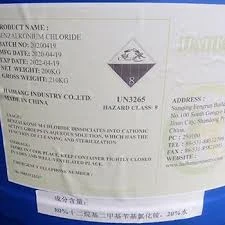Exploring the Properties and Applications of Polymaleic Anhydride in Modern Chemistry
Poly Maleic Anhydride An Overview of Applications and Properties
Poly Maleic Anhydride (PMA) is a versatile chemical compound widely recognized for its unique properties and diverse applications. As a polymeric form of maleic anhydride, PMA is characterized by its robust structure, which gives it the ability to interact effectively with a range of substances, making it valuable in several industries including pharmaceuticals, agriculture, and materials science.
Chemical Structure and Properties
PMA is synthesized through the polymerization of maleic anhydride, a cyclic anhydride that can undergo various reactions such as copolymerization and grafting with other monomers. This process results in a polymer with reactive anhydride groups that can easily participate in further chemical reactions. The presence of these anhydride functionalities contributes to PMA’s chemical reactivity, enabling it to form derivatives that can enhance its performance in specific applications.
One of the notable physical properties of PMA is its ability to form stable aqueous solutions. This characteristic is particularly significant when PMA is employed in water treatment processes, where it acts as a dispersant, scale inhibitor, or flocculating agent. The polymer's molecular weight and degree of polymerization can be tailored during synthesis, allowing manufacturers to optimize PMA for particular end uses.
Applications
1. Water Treatment PMA is extensively used in the water treatment industry due to its excellent ability to inhibit scale formation and disperse particulates. It can be applied in cooling water systems, boilers, and wastewater treatment facilities to improve system efficiency and prolong equipment lifespan. The effectiveness of PMA in these applications stems from its anionic charge, which helps it bind to positively charged particles, thus preventing aggregation and scale buildup.
polymaleic anhydride

2. Pharmaceuticals In the pharmaceutical sector, PMA serves as a key excipient in drug formulations. Its hydrophilic nature aids in the solubilization of poorly soluble drugs, enhancing their bioavailability. Moreover, PMA can be employed as a drug delivery system thanks to its ability to form nanoparticles that can encapsulate active pharmaceutical ingredients. This capability not only protects the drug but also facilitates controlled and targeted release in the body.
3. Agriculture PMA finds applications as a polymeric adjuvant in agricultural formulations. Its ability to modify the surface tension of spray solutions helps improve the efficacy of herbicides, pesticides, and fungicides by enhancing their adhesion to plant surfaces. This leads to better penetration and uptake, providing enhanced pest control and improved crop yields.
4. Adhesives and Sealants PMA is also utilized in the production of adhesives and sealants, where its adhesive properties and chemical resistance are highly valued. The polymer’s compatibility with various substrates allows it to be used in formulations that require strong bonding characteristics, making it suitable for construction, automotive, and aerospace applications.
5. Coatings In coatings technology, PMA acts as a dispersing agent to enhance the stability and performance of pigment suspensions. Its incorporation within coating formulations helps improve the uniformity of the paint, ensuring better application and finish quality. The polymer’s adhesion properties also contribute to the durability and longevity of the coatings.
Conclusion
Poly Maleic Anhydride is a multifunctional polymer whose diverse applications stem from its unique chemical properties. Its ability to interact with various substances makes it a critical component in water treatment, pharmaceuticals, agriculture, adhesives, and coatings. As industries continue to seek innovative solutions to complex challenges, PMA's versatility ensures that it will remain an important material for future developments. With ongoing research aimed at enhancing its properties and exploring new applications, the potential for PMA is vast, promising advancements that will contribute positively to several fields. As a key player in the chemical industry, Poly Maleic Anhydride exemplifies how one compound can have far-reaching implications across multiple sectors.
-
Water Treatment with Flocculant Water TreatmentNewsJun.12,2025
-
Polymaleic AnhydrideNewsJun.12,2025
-
Polyaspartic AcidNewsJun.12,2025
-
Enhance Industrial Processes with IsothiazolinonesNewsJun.12,2025
-
Enhance Industrial Processes with PBTCA SolutionsNewsJun.12,2025
-
Dodecyldimethylbenzylammonium Chloride SolutionsNewsJun.12,2025





